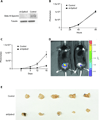Whole Exome Sequencing Reveals the Order of Genetic Changes during Malignant Transformation and Metastasis in a Single Patient with NF1-plexiform Neurofibroma
- PMID: 25925892
- PMCID: PMC4573781
- DOI: 10.1158/1078-0432.CCR-14-3049
Whole Exome Sequencing Reveals the Order of Genetic Changes during Malignant Transformation and Metastasis in a Single Patient with NF1-plexiform Neurofibroma
Abstract
Purpose: Malignant peripheral nerve sheath tumors (MPNST) occur at increased frequency in individuals with neurofibromatosis type 1 (NF1), where they likely arise from benign plexiform neurofibroma precursors. While previous studies have used a variety of discovery approaches to discover genes associated with MPNST pathogenesis, it is currently unclear what molecular events are associated with the evolution of MPNST from plexiform neurofibroma.
Experimental design: Whole-exome sequencing was performed on biopsy materials representing plexiform neurofibroma (n = 3), MPNST, and metastasis from a single individual with NF1 over a 14-year period. Additional validation cases were used to assess candidate genes involved in malignant progression, while a murine MPNST model was used for functional analysis.
Results: There was an increasing proportion of cells with a somatic NF1 gene mutation as the tumors progressed from benign to malignant, suggesting a clonal process in MPNST development. Copy number variations, including loss of one copy of the TP53 gene, were identified in the primary tumor and the metastatic lesion, but not in benign precursor lesions. A limited number of genes with nonsynonymous somatic mutations (βIII-spectrin and ZNF208) were discovered, several of which were validated in additional primary and metastatic MPNST samples. Finally, increased βIII-spectrin expression was observed in the majority of MPNSTs, and shRNA-mediated knockdown reduced murine MPNST growth in vivo.
Conclusions: Collectively, the ability to track the molecular evolution of MPNST in a single individual with NF1 offers new insights into the sequence of genetic events important for disease pathogenesis and progression for future mechanistic study.
©2015 American Association for Cancer Research.
Conflict of interest statement
Figures




Similar articles
-
Whole-exome sequencing of breast cancer, malignant peripheral nerve sheath tumor and neurofibroma from a patient with neurofibromatosis type 1.Cancer Med. 2015 Dec;4(12):1871-8. doi: 10.1002/cam4.551. Epub 2015 Oct 3. Cancer Med. 2015. PMID: 26432421 Free PMC article.
-
Molecular evolution of a neurofibroma to malignant peripheral nerve sheath tumor (MPNST) in an NF1 patient: correlation between histopathological, clinical and molecular findings.J Cancer Res Clin Oncol. 2010 Dec;136(12):1869-80. doi: 10.1007/s00432-010-0846-3. Epub 2010 Mar 15. J Cancer Res Clin Oncol. 2010. PMID: 20229272 Free PMC article.
-
Confirmation of mutation landscape of NF1-associated malignant peripheral nerve sheath tumors.Genes Chromosomes Cancer. 2017 May;56(5):421-426. doi: 10.1002/gcc.22446. Epub 2017 Mar 7. Genes Chromosomes Cancer. 2017. PMID: 28124441
-
Genetically engineered mouse models shed new light on the pathogenesis of neurofibromatosis type I-related neoplasms of the peripheral nervous system.Brain Res Bull. 2012 May 1;88(1):58-71. doi: 10.1016/j.brainresbull.2011.08.005. Epub 2011 Aug 10. Brain Res Bull. 2012. PMID: 21855613 Free PMC article. Review.
-
Recent advances in neurofibromatosis type 1.Curr Opin Neurol. 2004 Apr;17(2):101-5. doi: 10.1097/00019052-200404000-00004. Curr Opin Neurol. 2004. PMID: 15021234 Review.
Cited by
-
Reprogramming Captures the Genetic and Tumorigenic Properties of Neurofibromatosis Type 1 Plexiform Neurofibromas.Stem Cell Reports. 2019 Feb 12;12(2):411-426. doi: 10.1016/j.stemcr.2019.01.001. Epub 2019 Jan 31. Stem Cell Reports. 2019. PMID: 30713041 Free PMC article.
-
Genomic Status of MET Potentiates Sensitivity to MET and MEK Inhibition in NF1-Related Malignant Peripheral Nerve Sheath Tumors.Cancer Res. 2018 Jul 1;78(13):3672-3687. doi: 10.1158/0008-5472.CAN-17-3167. Epub 2018 May 2. Cancer Res. 2018. PMID: 29720369 Free PMC article.
-
Spatially- and temporally-controlled postnatal p53 knockdown cooperates with embryonic Schwann cell precursor Nf1 gene loss to promote malignant peripheral nerve sheath tumor formation.Oncotarget. 2016 Feb 16;7(7):7403-14. doi: 10.18632/oncotarget.7232. Oncotarget. 2016. PMID: 26859681 Free PMC article.
-
Chromosome 8 gain is associated with high-grade transformation in MPNST.JCI Insight. 2021 Mar 22;6(6):e146351. doi: 10.1172/jci.insight.146351. JCI Insight. 2021. PMID: 33591953 Free PMC article.
-
Conditionally replicative adenovirus as a therapy for malignant peripheral nerve sheath tumors.Mol Ther Oncol. 2024 Feb 28;32(2):200783. doi: 10.1016/j.omton.2024.200783. eCollection 2024 Jun 20. Mol Ther Oncol. 2024. PMID: 38595983 Free PMC article.
References
-
- Arun D, Gutmann DH. Recent advances in neurofibromatosis type 1. Current opinion in neurology. 2004;17:101–105. - PubMed
-
- Hirbe AC, Gutmann DH. Neurofibromatosis type 1: a multidisciplinary approach to care. The Lancet Neurology. 2014;13:834–843. - PubMed
-
- Upadhyaya M, Spurlock G, Monem B, Thomas N, Friedrich RE, Kluwe L, et al. Germline and somatic NF1 gene mutations in plexiform neurofibromas. Human mutation. 2008;29:E103–E111. - PubMed
-
- Rasmussen SA, Overman J, Thomson SA, Colman SD, Abernathy CR, Trimpert RE, et al. Chromosome 17 loss-of-heterozygosity studies in benign and malignant tumors in neurofibromatosis type 1. Genes, chromosomes & cancer. 2000;28:425–431. - PubMed
Publication types
MeSH terms
Substances
Grants and funding
LinkOut - more resources
Full Text Sources
Medical
Research Materials
Miscellaneous

